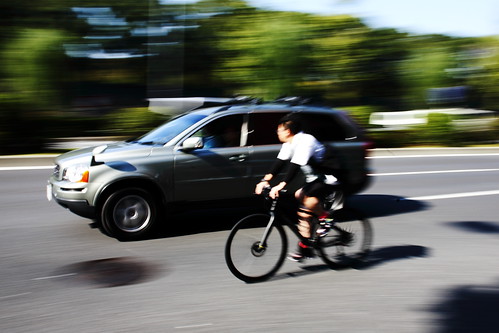The time is 8:15 am. You have a meeting at 8:45am. This leaves you with 15 minutes to get to work and make sure your hair doesn’t look like a character from Avatar. What do you do?
Two new studies out this month make the case that at rush hour, bikes can leave cars and public transportation in the dust, while other studies show the number of daily bikers is taking off.
First, compare cars to bikes. A recent article in the MIT Technology Reviewdraws on data from 11.6 million bicycle trips in the French city of Lyon between May 2005 and December 2007. The data shows that, on average, bicyclists travel nearly as fast as cars and that, at rush hour, the average speed of cyclists actually outstrips that of the average car — and this doesn’t include time for parking.
Some claim that this data doesn’t apply to American cities, many of which, unlike Lyon, are built on a grid. I’m in the camp that uses this science to make an unscientific claim: bikes can, in the right conditions, travel faster than cars when commuting. For the 9 out of 10 Americans who drive to work in a private car, this may well come as a surprise.
Another tool makes the comparison of public transportation to biking quite vividly. Mapnificient.net will show you how long it will take you to get to any part of a city of your choice at any time of day and within any time limits. It also lets you specify whether you have a bike with you. Say you select New York City, 8 a.m., starting point of the Washington Square area and a travel time of at most 15 minutes. The highlighted area (where you can travel) bubbles out to encompass southern Manhattan. Indicate that you’ll be carrying a bike, however, and your reach extends out impressively. This isn’t specific to New York City, either; I replicated this comparison in cities such as Chicago, Minneapolis, Denver, Dallas, and even London. All returned the same result.
I grant that this model doesn’t work in all locations for all people. Cities like San Francisco, that boast hilly terrain, are likely not suitable for this model. Nor are bikes a suitable replacement for all other forms of transportation; in a modern city, each has its place. However, these studies do suggest a general rule of commuting: bikes are faster than cars, in the right situation. That by itself is significant.
The good news for cycling supporters is that more Americans are realizing this. According to the American Community Survey, in cities like Boston and Washington, D.C., ridership is up 165 percent and 108 percent respectively over 2005 levels. In New York, where Mayor Bloomberg has constructed over 200 miles of new bike lanes in the last four years, ridership has doubled since 2005, according to the Wall Street Journal.
The rest of the country may be less enthusiastic about cycling, but they’re more enthusiastic than they were. According to the American Community Survey, between 2005 and 2009, bike commuting grew by 0.3 percent. Nothing, you say? It’s something, surely.
Source: Originally published in On Earth, December 13, 2008.
(Photo provided courtesy of megawheel360 @ flickr. Used under the Creative Commons license.)

